|
Some basics for bootmen

Civil War Cavalry Boots |
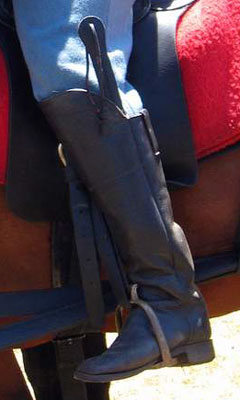
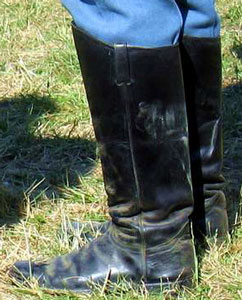
|
Standard cavalry issue during the American Civil War was the Wellington
Boot. In 1815 Arthur Wellsley, First Duke of Wellington, defeated Napoleon
at Waterloo. The popular victor became a national icon and both men and
women emulated his style of footwear. The modern Wellington had a
low cut heel and the shaft was calf high (about 12" to 14") and not thigh high.
This made them easier to mass produce. These boots became known as "cavalry
boots" and were often made of hard, black leather called kip. Bootmakers
based their designs on Northern European riding boots. The most popular was
the Coffeyville Boot from Coffeyville, Kansas. It combined the various US
Cavalry styles and the original British leather Wellington boot.
After much experimentation by the Quartermaster Corps during and after the
Civil War, an oak-tanned Spanish leather which was heavily waxed on the flesh
side became the standard. And it was from this waxed calf that most of the
early cowboy boots were constructed, as well.
|
| |
POOR QUALITY CAVALRY BOOTS INTRODUCE
ENGLISH WORDS AND PHRASES |
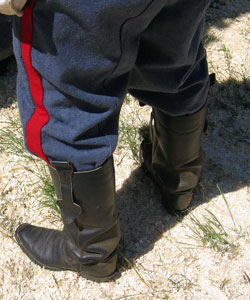
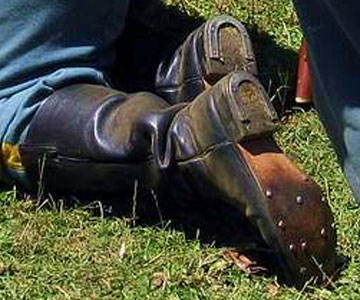
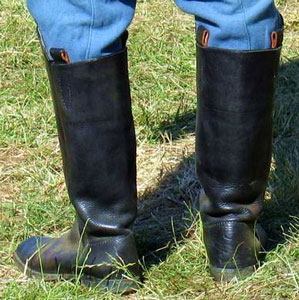
| Unfortunately during the American Civil War (1861-1865)
unscrupulous contractors supplied below par footwear and many of the cavalry
boots were mass produced using reinforced cardboard. Climatic conditions
took their toll and the soldiers suffered deep cuts to their feet. The English
language was enriched with the word shoddy which described manufacturers
willing to compromise quality for profit. Many experts believe the final victory
was in no small part due to the superior footwear of the Union army.
About 1865, the US Government issued new boots to soldiers. The boots had
brass tacks to hold the leather soles of the boots on. As the soles were worn
down, the tacks would protrude through the bottom into the soldiers feet. The
government put together a committee to study the problem and suggested a solution.
Their solution was to issue each soldier a metal file to file down the points
of the tacks as they pushed through the boot sole. (Some things never change, do
they?) The term "brass tacks" could mean to get to the absolute bottom of things
(in original reference to soldier's boots).
By the end of the Civil War, the federal government had half a million
pairs of boots surplus to requirements. Systematically thereafter troops stationed
on the frontier were supplied with shoddy boots. Shoe historians believe the
foundation of the cowboy boot trade in the frontier was based on the simple
necessity for civilian bootmakers to replace defective military footwear.
|
| |
| OFFICER'S BOOTS |
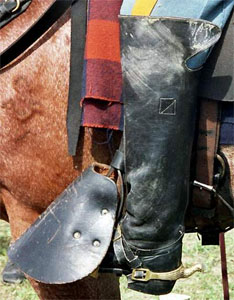 |
Boots worn by Civil War officers were provided by private sutlers
(a trader who sold drink and provisions to the troops). Officer's boots were not
standard government issue. These Boots as shown here were usually from 15" to 19"
high, and had a knee flap on the top front of the boot, which provided protection
to an officer's legs and knees while riding a horse, mounting, or dismounting.
On some officer's boots, there was an extrusion of leather on each side of the
knee flap which could be tied around the leg to hold the boot up and in place.
|
| |
| NO LEFT OR RIGHT BOOT |
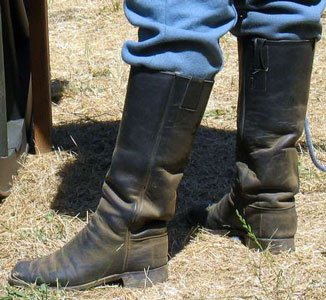 |
During the American Civil War, boots were made upon straight
lasts, meaning that each boot was the same and there was no "right" or "left"
boot. What may look like a right or left boot in the picture here actually are
straight-last boots that comformed to the curvature of the foot when they were
broken in. Right and left boots were introduced after the Civil War but were not
popular. It took another 50 years before the masses accepted boots made for
right and left feet.
|
| |
|
Content from Wikipedia, Curtain University, DaveM, and Booted Harleydude. Pictures courtesy of DaveM, used with permission.
Text from Wikipedia article on
Cowboy Boots and
Wellington Boots
and as edited and contributed to by Booted Harleydude. Text of this article is licensed
under the GNU Free Documentation License.
|

Tutorial - Types of Boots
Boot Information Resources
Boot Information Page Index
|

